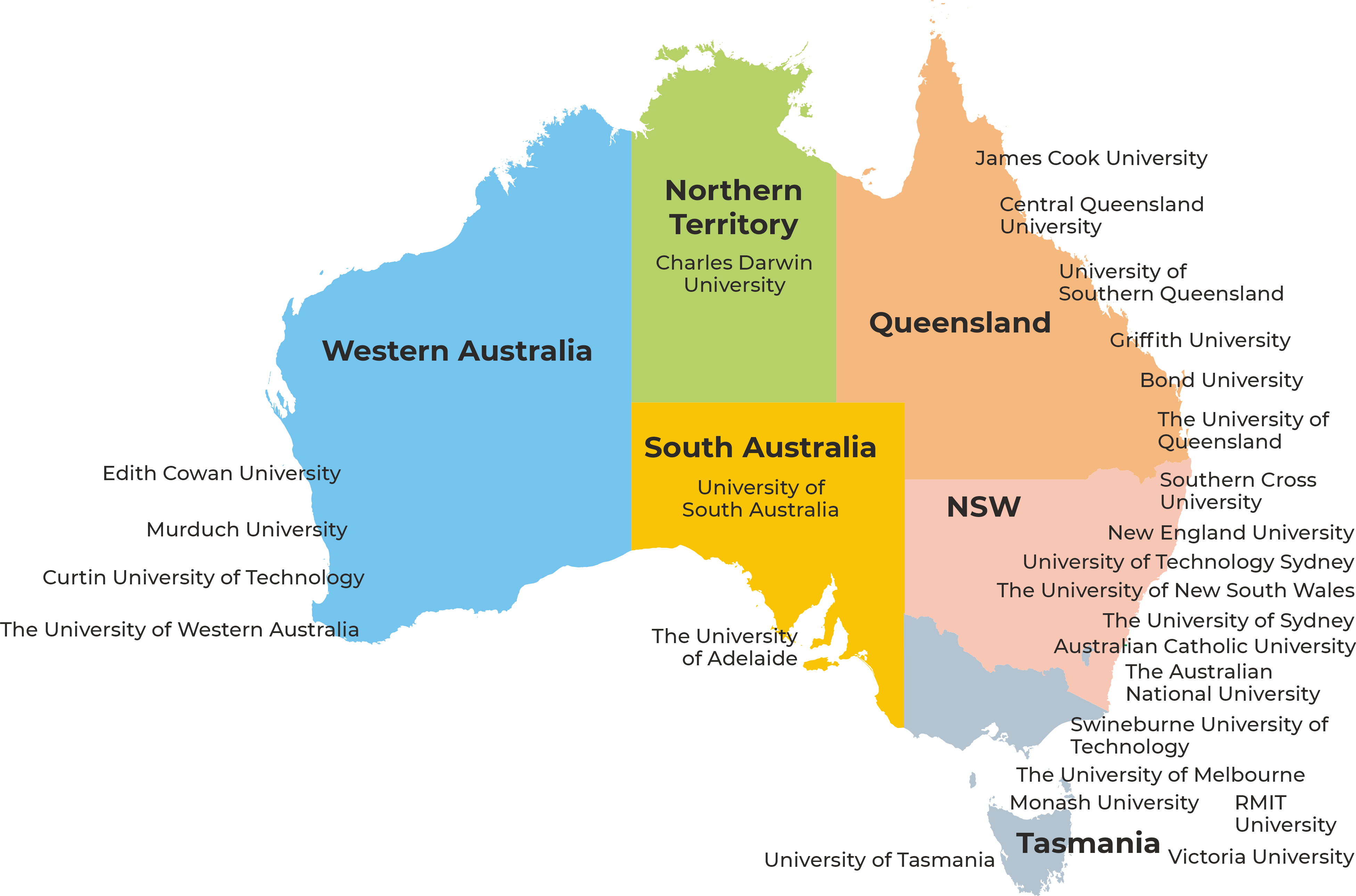Study In Australia
QUICK FACTS
About Australia
Smallest continent of the world
Divided into
Capital city
Other major cities
Language
Climate
Climate
Diverse Community
Career Opportunity
Major Sector in Economy
Major Australia Universities
TEQSA is the national regulatory and quality agency for higher education. Students’ rights are protected by law under ESOS act.
There are 43 universities in Australia 40 Australian Universities 02 International universities 01 Private specialty university
Why study in Australia?
- A diverse and welcoming country- Out of 23 million Australians, nearly 47% are born outside the country or have one parent born overseas.
- Economically stable- Australia has experienced more than 20 years of continued economic growth
- Australia has been ranked as fourth happiest country in the world, behind only Norway, Sweden and Denmark.
- Third most popular international student destination in the world
- 8 out of top 100 universities are Australian
- Out of the 30 best student cities, 5 cities are in Australia
- 8th in the world in terms of University ranking, ahead of the UK, Germany, Japan and Netherlands
- Over $200 million annual Government investment on International scholarships

Why study in Australia?
- A diverse and welcoming country- Out of 23 million Australians, nearly 47% are born outside the country or have one parent born overseas.
- Economically stable- Australia has experienced more than 20 years of continued economic growth
- Australia has been ranked as fourth happiest country in the world, behind only Norway, Sweden and Denmark.
- Third most popular international student destination in the world
- 8 out of top 100 universities are Australian
- Out of the 30 best student cities, 5 cities are in Australia
- 8th in the world in terms of University ranking, ahead of the UK, Germany, Japan and Netherlands
- Over $200 million annual Government investment on International scholarships
- Australian discoveries and innovations includes – penicillin, IVF, ultrasound, Wi-Fi, the Bionic Ear, cervical cancer vaccine and Black Box Flight Recorders
Top University
Minimum 60% marks in the last passed examination
IELTS– Bands 6.0 for Bachelor’s and Bands 6.5 Bands for Master’s Degree
Certain universities and courses may have certain specific IELTS requirement
ELICOS is available for the candidates who have scored less in IELTS
Educational programs in Australia are delivered through Public and Private Universities, Colleges, Vocational Education and Training (VET) schools and TAFEs. All levels and qualifications are monitored for quality standards under Australian Qualifications Framework (AQF). The programs levels are:
- Certificate (Level 1 to 4)
- Diploma (Level 5)
- Advanced Diploma; Associate Degree (Level 6)
- Bachelor Degree (Level 7)
- Bachelor (Honors), Graduate Certificate/Diploma (Level 8)
- Master Degree (Level 9)
- Doctoral Degree (Level 10)
The educational system in Australia focus on actual learning for course outcomes. Thus, the courses and qualifications are designed as per industry labor needs so that the graduates are job ready. Classes are delivered through comprehensive teaching coupled with practical demonstrations on advanced technology actual set-up.
- Primary School: From Kindergarten to next 7-8 years
- Secondary School: For 3 or 4 years from the age group of 7-10 or 8-10 years.
- Senior School: Starts from 11 -12 years age bracket and continues for 2 years.
- Tertiary Education: Consists higher education, TAFE and Vocational Education & Training (VET)
Australian education system is divided into following divisions as per age growth:
- 17 Lakhs INR (For 01-year Tuition Fee)
- 11 Lakhs INR (For 01-year Living Expenses)
- 02 Lakhs INR (Tickets + Visa Fee + other miscellaneous)
- Get ready with academic & English test scores
- Application for admission in university
- Receipt of offer letter
- Fulfilling GTE requirements + submission of financial papers
- Fee payment for 01st year/01st Semester
- eCOE (Confirmation of Enrolment
- Medical + Visa application
- Decision of application
Post study opportunities
- Graduate work (18 months) for diploma, degree or trade qualification meeting Australia study requirements and nominating a qualification on OSL
- Post-study work (up to 4 years- in certain regional areas) for those completing an Australian higher education qualification (Bachelors or masters) irrespective of the field of study
Student successfully completing at least two academic years in Australia towards, gaining a qualification /award is eligible for Temporary Graduate Visa (subclass 485). This visa has two streams:
Genuine Temporary Entrant (GTE) – Defined
- The applicant’s circumstances in India-academic & employment
- The applicant’s potential circumstances in Australia-
course of study & university - Language ability
- Immigrant history
- Financial capacity
he genuine temporary entrant requirement (GTE) is an integrity measure to ensure that the Student visa Programme is used as intended and not used by international students as a way of acquiring permanent residency in Australia. Following factors considered by Universities & Govt. to assess GTE significance;











